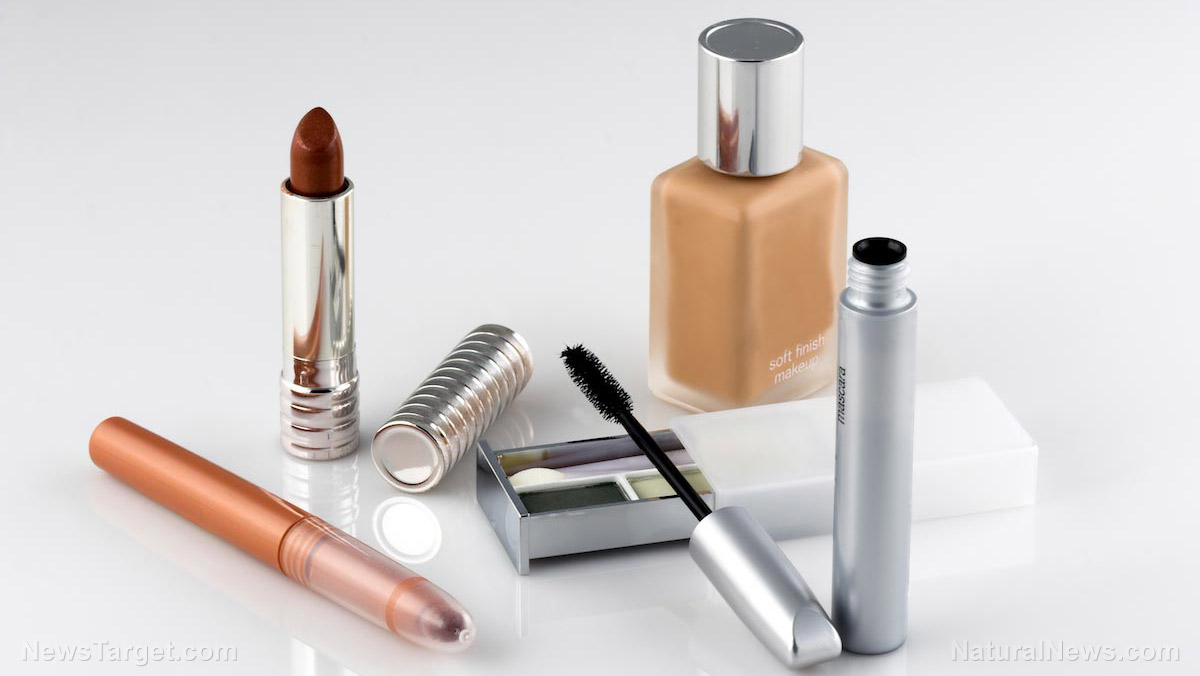7 TOXIC ingredients in cosmetics and personal care products
08/15/2023 / By Olivia Cook

A new study that tested for chemicals in hundreds of products has found that toxic per- and polyfluoroalkyl substances (PFAS), also known as “forever chemicals,” are widely used in cosmetics produced by major brands in the U.S. and Canada. The products tested include blush, concealer, eyeliner, foundation, lip balm, lipstick, mascara nail polish and nail polish remover.
Given how loosely the cosmetics industry is regulated by the U.S. Food and Drug Administration (FDA), it’s important to get every available information you can about these products.
Here’s how research breaks down the science of beauty and what it says about the toxic ingredients in cosmetics and other personal care products. (Related: Skin care expert reveals the 20 most toxic chemical ingredients in beauty products…Are you poisoning yourself?)
Aluminum
The toxic metal aluminum functions as a pigment and thickening agent in antiperspirants, deodorants, eye makeup and lipsticks.
A 2005 study found that constant application of antiperspirants containing aluminum chloride or aluminum chlorohydrate is linked to an increase in breast cancer risk because of aluminum’s ability to mimic estrogen in the body.
There has been a 50-year debate about whether or not aluminum exposure can lead to Alzheimer’s after a study found that injecting aluminum into rabbits’ brains led to the formation of a protein associated with the degenerative disease.
Coal tar
Coal tar is used in over-the-counter (OTC) shampoos and skin care products formulated for the treatment of dandruff, psoriasis and seborrheic dermatitis.
It is considered a carcinogen by the National Toxicology Program and the International Agency for Research on Cancer.
Coal tar is a complex chemical mixture that also includes a number of suspected and known carcinogens, such as anthracene, benzene, creosote oils, naphthalene, toluene, xylene and benzo[a]pyrene, which is a polycyclic aromatic hydrocarbon (PAH) – a large class of chemicals expected to cause cancer.
Formaldehyde
Formaldehyde is used as a preservative to prolong shelf life of beauty products and prevent bacterial contamination.
Formaldehyde is commonly present in deodorants, eyelash glue, hair gels, lotions, makeup products, nail hardeners, nail polishes, soaps and shampoos. The chemical is also used in hair-straightening products.
The most common formaldehyde releasers used by the cosmetics industry are bronopol, DMD hydantoin, glyoxal, methylene glycol and quaternium 15.
Formaldehyde is an irritant to the skin, throat, nose and eyes. It can also cause hair loss, scalp burns and hormonal problems. In 2011, the U.S. government declared formaldehyde as a human carcinogen.
Lead acetate
You can find lead in eyeliners, foundation, lipsticks and whitening toothpastes.
Once absorbed into the body, lead can be found in the blood, bones and soft tissues. High concentrations of lead may cause coronary heart disease and hypertension, according to a study published in Environmental Health Perspectives.
Lead is a potent neurotoxin that can affect brain development, hormonal balance and reproductive health – even in small concentrations.
Petroleum distillates
Petroleum distillates can be used to dissolve other substances, usually liquids in cosmetics and personal care products.
You can expect to find petroleum and petroleum byproducts in everything from shampoos and conditioners to anti-aging creams, body lotions, conditioners, eye shadow, foundations, hair relaxers, lipsticks, lip balms, mascaras, nail polishes and perfumes.
Petroleum is often listed on the label under cleverly disguised names, such as mineral oil or words ending in “eth,” which indicates that a petrochemical was used during production.
Some of these petroleum products, such as benzene and ethylene oxide, are known or potential cancer-causing agents, while others are hormone disruptors (e.g., parabens).
Mineral oil, which is a popular and common ingredient in baby oil and a wide range of skin and hair products, may contain contaminants and can clog your pores, increasing your risk of having acne and blackheads and inhibiting your skin from breathing.
Even worse, when your skin is exposed to petroleum-derived products, it absorbs the chemicals (some of which are potentially carcinogenic), which then get into your bloodstream. This is dangerous for everyone, especially children, women who are pregnant and the developing fetus they carry.
Phthalates
Historically, the primary phthalates used in cosmetic products were dibutyl phthalate (DBP), which is used as a plasticizer in products; dimethyl phthalate (DMP), which is used in hair sprays; and diethyl phthalate (DEP), which is used as a solvent and fixative in fragrances.
Phthalates are often a source of allergies. They can disrupt the endocrine system and cause hormonal problems. They also increase the risk of breast cancer and congenital reproductive disabilities, as indicated in a study published in Endocrine Reviews.
Toluene
Found in nail polish and nail polish remover, toluene is used as a solvent to dissolve other substances, such as resins and plasticizers.
Toluene can be highly toxic to the immune system and central nervous system. It can cause birth defects, headache, fatigue, drowsiness and nausea, and can increase the risk of blood cancer.
According to renowned skincare expert Dr. Trevor Cates, toluene is a potent neurotoxic chemical that could trigger impaired breathing and nausea. Toluene is commonly found in nail care products.
Watch the following video to learn more about the toxins commonly found in cosmetics.
This video is from the PureTrauma357 channel on Brighteon.com.
More related stories:
Study: Toxic FOREVER CHEMICALS are found in many cosmetics.
Toxic chemicals in cosmetics are increasingly HARMING consumers.
Lax regulations allow cosmetics industry to sell products contaminated with infectious pathogens.
Sources include:
Submit a correction >>
Tagged Under:
aluminum, cancer criminals, carcinogens, coal tar, cosmetics, Endocrine disruptors, formaldehyde, health science, lead, neurotoxin, petroleum distillates, phthalates, poison, products, toluene, toxic chemicals, toxic ingredients, toxins, women's health
This article may contain statements that reflect the opinion of the author
RECENT NEWS & ARTICLES
COPYRIGHT © 2019 Dangerous.News
All content posted on this site is protected under Free Speech. Dangerous.News is not responsible for content written by contributing authors. The information on this site is provided for educational and entertainment purposes only. It is not intended as a substitute for professional advice of any kind. Dangerous.News assumes no responsibility for the use or misuse of this material. All trademarks, registered trademarks and service marks mentioned on this site are the property of their respective owners.




















